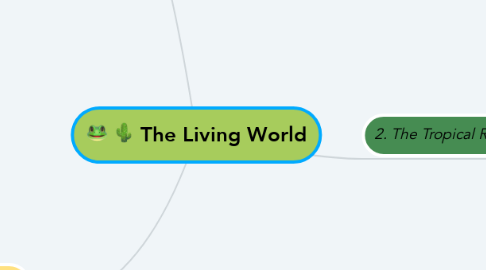
1. 1. Ecosytem
1.1. Interdependence
1.1.1. Abiotic/Biotic characteristics
1.1.2. Food chains/Webs
1.1.2.1. Producers/Consumers/Decomposers
1.1.3. Nutrient Cycling
1.1.3.1. Biomass
1.2. Example: Small scale ecosystem (UK)
1.2.1. Epping Forest (Deciduous woodland)
1.3. Impact of change in an ecostems
1.3.1. Trophic Cascade
1.3.2. Example: Grey Wolf in Yellowstone, USA
1.4. Biomes
1.4.1. Distribution
1.4.1.1. Link to Global Atmospheric Circulation
1.4.2. Characteritics
2. 2. The Tropical Rainforest
2.1. Characteristics
2.1.1. Climate
2.1.1.1. Link: Climate Graphs
2.1.1.2. Link: Convectional rainfall
2.1.2. Soil
2.1.3. Layers of the TRF
2.1.4. Adaptations
2.1.4.1. Plants
2.1.4.1.1. Buttress Roots
2.1.4.1.2. Drip Tip Leaves
2.1.4.2. Animals
2.1.4.2.1. Toucan
2.1.4.2.2. Aye Aye
2.1.5. Biodiverity
2.1.5.1. Human Activity reducing biodiversity
2.2. CASE STUDY: AMAZON DEFORESTATION
2.2.1. 20% of the Amazon biome has already been lost and the trend will worsen if gone unchecked.
2.2.1.1. WWF estimates that 27 per cent – more than a quarter – of the Amazon biome will be without trees by 2030 if the current rate of deforestation continues.
2.2.2. Causes
2.2.2.1. Cattle Ranching
2.2.2.1.1. Imp: Soil erosion, polllution, habitat loss
2.2.2.2. Mineral Extraction
2.2.2.2.1. Imp: Pollution
2.2.2.3. Agricultural land/crops
2.2.2.3.1. Imp: Fertilisers = pollution, soil degradation
2.2.2.4. Road and rail links
2.2.2.4.1. Imp: Deforestation, increased access for exploitation
2.2.3. Impacts
2.2.3.1. Global
2.2.3.1.1. Global Warming
2.2.3.2. National
2.2.3.2.1. Loss of biodiversity in the Amazon
2.2.3.3. Local
2.2.3.3.1. Pollution
2.3. Sustainability
2.3.1. Value of the TRF
2.3.1.1. Goods
2.3.1.1.1. Medicine
2.3.1.2. Services
2.3.1.2.1. Carbon Capture
2.3.2. Management
2.3.2.1. Global
2.3.2.1.1. International Agreements
2.3.2.1.2. Conservation by NGOs
2.3.2.2. National
2.3.2.2.1. Government policy
2.3.2.3. Local
2.3.2.3.1. Selective logging
2.3.2.3.2. Agroforestry
2.3.2.3.3. Ecotourism
3. 3. Hot Deserts
3.1. Characteristics
3.1.1. Climate
3.1.1.1. Link: Climate Graphs
3.1.1.2. Link: GAC
3.1.2. Soil
3.1.3. Adaptations
3.1.3.1. Plants
3.1.3.1.1. Cacti
3.1.3.1.2. Desert flowers
3.1.3.2. Animals
3.1.3.2.1. Camels
3.1.3.2.2. Desert foxes
3.1.4. Biodiversity
3.1.4.1. Fragile environment
3.2. CASE STUDY: DEVELOPMENT Western Desert (Textbook) or Sahara
3.2.1. Opportunities
3.2.1.1. Mineral Extraction
3.2.1.2. Solar Energy
3.2.1.3. Farming
3.2.1.4. Tourism
3.2.2. Challenges
3.2.2.1. Extreme temperature
3.2.2.2. Water Supply
3.2.2.3. Inaccessibility
3.3. Desertification
3.3.1. Causes
3.3.1.1. Human
3.3.1.1.1. Pop. growth
3.3.1.1.2. Fuel wood collection
3.3.1.1.3. Overgrazing
3.3.1.1.4. Soil erosion
3.3.1.2. Physical
3.3.1.2.1. Climate change
3.3.1.2.2. Long term reductions in rainfall
3.3.2. Strategies
3.3.2.1. Afforestation
3.3.2.2. Technology
3.3.2.2.1. new cooking methods
3.3.2.3. Soil and water management

